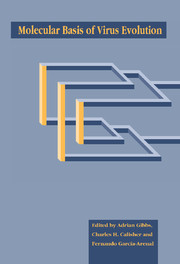Book contents
- Frontmatter
- Contents
- List of contributors
- Editors' preface
- Conference participants
- 1 Introduction and guide
- Part I The impact of viral diseases
- Part II Origins of viruses and their genes
- Part III Sources of virus variation
- Part IV Molecular interactions of viruses and their hosts
- Part V Viruses, hosts and populations
- Part VI Case studies of viral taxa; their systematics and evolution
- 18 Evolution of poxviruses and African swine fever virus
- 19 Molecular systematics of the flaviviruses and their relatives
- 20 Herpesviridae
- 21 Aphthovirus evolution
- 22 Evolution of the Bunyaviridae
- 23 Evolution of the tobamoviruses
- 24 The luteovirus supergroup: rampant recombination and persistent partnerships
- 25 The evolution of the Reoviridae
- 26 Genetic variation and evolution of satellite viruses and satellite RNAs
- 27 Molecular evolution of the retroid family
- 28 Adaptation of members of the Orthomyxoviridae family to transmission by ticks Patricia
- 29 The Order Mononegavirales: evolutionary relationships and mechanisms of variation
- 30 The molecular evolution of the human immunodeficiency viruses
- 31 Molecular evolution of papillomaviruses
- 32 Molecular systematics of the Potyviridae, the largest plant virus family
- 33 Evolution of alphaviruses
- 34 Evolution of influenza viruses: rapid evolution and stasis
- Part VII Techniques for viral systematics
- Index
27 - Molecular evolution of the retroid family
Published online by Cambridge University Press: 04 May 2010
- Frontmatter
- Contents
- List of contributors
- Editors' preface
- Conference participants
- 1 Introduction and guide
- Part I The impact of viral diseases
- Part II Origins of viruses and their genes
- Part III Sources of virus variation
- Part IV Molecular interactions of viruses and their hosts
- Part V Viruses, hosts and populations
- Part VI Case studies of viral taxa; their systematics and evolution
- 18 Evolution of poxviruses and African swine fever virus
- 19 Molecular systematics of the flaviviruses and their relatives
- 20 Herpesviridae
- 21 Aphthovirus evolution
- 22 Evolution of the Bunyaviridae
- 23 Evolution of the tobamoviruses
- 24 The luteovirus supergroup: rampant recombination and persistent partnerships
- 25 The evolution of the Reoviridae
- 26 Genetic variation and evolution of satellite viruses and satellite RNAs
- 27 Molecular evolution of the retroid family
- 28 Adaptation of members of the Orthomyxoviridae family to transmission by ticks Patricia
- 29 The Order Mononegavirales: evolutionary relationships and mechanisms of variation
- 30 The molecular evolution of the human immunodeficiency viruses
- 31 Molecular evolution of papillomaviruses
- 32 Molecular systematics of the Potyviridae, the largest plant virus family
- 33 Evolution of alphaviruses
- 34 Evolution of influenza viruses: rapid evolution and stasis
- Part VII Techniques for viral systematics
- Index
Summary
Introduction
Membership in the retroid family (Fuetterer & Hohn, 1987) is defined by the shared amino acid sequence identity to the conserved motifs in the reverse transcriptase (RT) segment of the RNA-directed DNA polymerase. The retroid family is composed of retro viruses, two different classes of DNA viruses, two distinct types of retrotransposons, retroposons, group II introns and plasmids of cellular organelles, an orphan group, the retrons (Temin, 1989) of bacteria (Inouye et ai, 1989; Lampson, Inouye & Inouye, 1989; Lim & Maas, 1989) and the telomere elongation protein (EST-1) of yeast (Table 27.1) (Lundblad & Blackburn, 1990).
The variability of gene content and sequence similarity in extant retroid elements (Table 27.1) can be used to infer a model of the evolutionary history of the retroid family (Fig. 27.1). The phylogenetic tree topology, based on RT similarities, indicates an initial bifurcation leading to lineages I and II. Independently derived phylogenies for each set of homologous proteins in the capsid/ribonuclear protein/protease/ reverse transcriptase/ribonuclease H/histidine-cysteine motif/integrase (CA/NC/PR/RT/RH/H-C/IN) element and capsid/reverse transcriptase/ tether (CA/RT/T) element produce trees that are congruent with the RT tree, suggesting that the ancestral units evolved as linked genes (Doolittle et ai, 1989; McClure, 1992; McClure, unpublished data). The hypothetical ancestral unit of lineage I is further supported by the congruency of the phylogenetic tree for the H-C/IN segment, even though it is found in a position in the copia-likt retrotransposons different from its position in all other retroid elements. Subsequent acquisition or deletion of gene units may have occurred as indicated along the various branches leading to the tree tips (Fig. 27.1).
- Type
- Chapter
- Information
- Molecular Basis of Virus Evolution , pp. 404 - 415Publisher: Cambridge University PressPrint publication year: 1995
- 3
- Cited by



